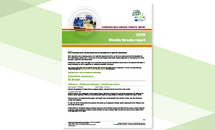Communicable disease threats report, 20-26 July 2014, week 30
The ECDC communicable disease threats report is a weekly bulletin intended for epidemiologists and health professionals in the area of communicable disease prevention and control. Summarising information gathered by ECDC through its epidemic intelligence activities regarding communicable disease threats of concern to the European Union, it also provides updates on the global situation and changes in the epidemiology of communicable diseases with potential to affect Europe, including diseases that are the focus of eradication efforts.
Executive Summary
This issue covers the period from 20 to 26 July 2014 and includes updates on:
Mass gathering monitoring: Commonwealth Games 2014
In collaboration with Health Protection Scotland, ECDC enhanced its monitoring activities during the Commonwealth Games in Scotland (23 July to 3 August 2014). During the past week, ECDC has not detected any events of public health significance to the Games.
West Nile virus
During the past week, no new human cases have been reported in the EU or in neighbouring countries. West Nile fever in humans is a notifiable disease in the EU.
Chikungunya, the Caribbean
Most of the areas previously affected by the outbreak that has been on-going since December 2013 continue to report cases. The situation is particularly severe on the island of Hispaniola, i.e. Haiti and the Dominican Republic, and Guadeloupe. Costa Rica, Venezuela, the Cayman Islands and the Republic of Trinidad and Tobago have now also notified local transmission of chikungunya infection. Jamaica and Colombia have reported imported cases during week 29.
ECDC published a risk assessment on 25 June and an epidemiological update on 30 June.
Outbreak of Ebola Virus Disease (EVD), West Africa
During the last week, the affected countries have reported 111 new cases and 47 new fatalities. The largest increase in cases since the previous update was reported in Sierra Leone, followed by Liberia and Guinea. As a follow-up action to the Emergency Ministerial meeting held in Ghana, the World Health Organization established a sub-regional outbreak coordination centre in Conakry (Guinea) on 16 July 2014 to meet the needs to control the outbreak.
This outbreak has been affecting Guinea, Liberia and Sierra Leone since December 2013. While this is the largest EVD outbreak reported, the risk of infection for travellers is considered very low.
ECDC published a risk assessment on 9 June and an epidemiological update on 17 July.
Middle East Respiratory Syndrome Coronavirus (MERS-CoV)
Since the last CDTR, one new fatal case has been reported by Iran. Saudi Arabia has reported additional deaths in previously reported cases. ECDC published its updated rapid risk assessment on MERS-CoV on 31 May 2014 and an epidemiological update on 5 June 2014.
Pneumonic plague, China
On 17 July 2014, Chinese health authorities reported a fatal case of pneumonic plague in a 38-year-old man from Yumen City (Gansu province). The patient was admitted to hospital on 15 July 2014 and died one day later. He was a farm worker and had a history of exposure to a dead marmot that he had fed his dog. In response, the Chinese authorities issued an emergency alert for the region and implemented control measures including isolation and prophylactic treatment of the patient’s close contacts. No further cases have been reported as of 23 July 2014, and the quarantine has been lifted as of 24 July.
Download






